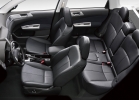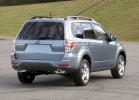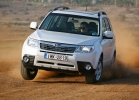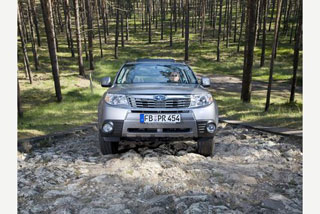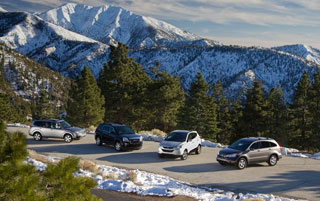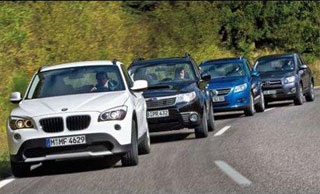Subaru Forester test drive since 2008 SUV
EF-five
Referred with Subaru Forester
Each Internet user is well familiar with the F5 key. This is Refresh, which allows you to restart the page in the browser. You click on the button, and the contents often become different, but with the previous structure. Restyling Subaru Forester 2011 went through the same scheme: almost nothing changed outside, and the filling became largely different. We drove from Minsk to Brest and tried to evaluate these innovations.
If Subaru has known about F5 for F5 for a long time, then the function of a new window for them seems to be inaccessible. At least when the conversation is about Forester, he has always been a conservative. He stood, held on like a Brest fortress. Even when changing generations, the continuity of forms and structures has always been preserved. What, it would seem, talk about restyling? But in fact, the last modernization brought many innovations. Plus, we received the most powerful version of the S -EDITION forester. As they say, the heir to the legendary Forester STI. Whether he is the heir or not, we will check it a little later, but for now, too, press Refresh and see what has changed in the Forester of the last model year?
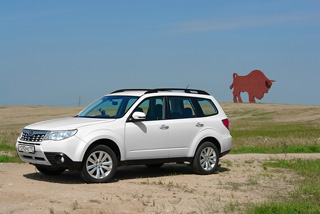
Forester is somewhat similar to the bison that live in Belarus: the look from the sneaky, a steep forehead, a powerful scruff, small folds on the hips. A very courageous appearance.
Only the expert will notice external differences. It was easier for me: there was a prerestyled foric nearby, and then I had to look thoroughly. New grille of the radiator, mirrors of a slightly different shape with LED turn signals
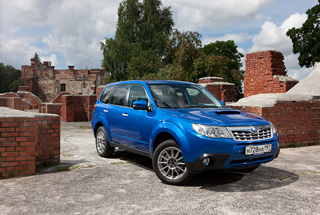
After restyling, Forester received a new radiator lattice, repeaters of turns indicators in the mirrors (except for version 2.0x), 17 -inch discs of new design and a couple of new colors of the blue Sky Blue Metallic and the Blue Marine Blue Pearl.
Is it all? It turns out that so, except for the refresher disks design and a couple of new colors. The top s -edit is slightly more different: it has a spoiler and a nominal nameplate on the trunk lid. Refresh is really very light.

The most powerful version is distinguished by the S-EDITION nameplate, anti-wing on the door of the trunk and 17-inch wheels with the STI logo.
The hellish heat in Belarus leaves no chance to survive in the open air and drives in cars to a saving air conditioner. By the way, it was not possible to cope with him. The climatic installation in Subaru has always worked according to a very strange algorithm, and it has not changed even after the appearance of a two -zone climate on expensive versions of the raying model. It is still very difficult to ensure that in the Auto mode, from nowhere, it doesn’t blow. The central nozzles are especially unsuccessful. Constantly have to adjust the fan speed and temperature. But the performance of the air conditioner is beyond praise, which in such a heat, of course, is very important.
Interior

Inside the Forester was slightly ennobled. The interior began to look better than on the previous model. The scales of devices with a toy blue backlight remained only on the simplest versions of 2.0x and 2.0xs, a new, more modern dietary panel appeared on all other modifications.
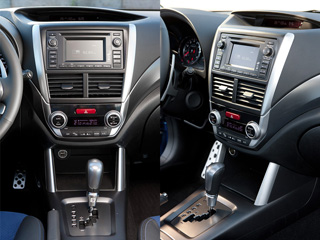
After restyling, Subaru had separate climate control and a 2Din radio with a 4.3-inch display and 7 columns. But, unfortunately, her sound still leaves much to be desired.
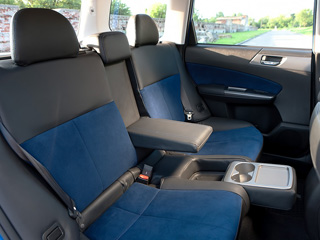
In the back row Forester, it is quite spacious. A person with a height of 185 centimeters sits behind himself without problems. In addition, passengers have not only a armrest, but also a leaning mini-old with cup holders.
In Forester, you can now talk on the phone using Bluetooth, and the new 2Din audio vocabulary with a 4.3 -inch color display and 7 columns is supplied in the basic set of equipment for all modifications, except the cheapest 2.0x. On two -liter versions, a new optronic panel of the devices will not be available. And this is a very strange differentiation, since the updated tidy is good in all respects: soft, not annoying backlight, large dials. But the connoisseur, again, will notice another upholstery of the seats and panels of the doors of more significant changes in the Forester salon.
But hopeless engines are completely new. No, no, fans of the brand may not worry: these are still opponents. Subaru continues to bend its line with the central location of the power unit and a decrease in the center of mass due to a unique layout. But the refresh of the engines turned out to be very deep.
The honored EJ engines series are rested, giving way to a more economical and environmentally friendly FB series. All improvements (there are quite a lot of them, you can read more about them in the appropriate inspection) were not even aimed at improving technical characteristics, but to optimize the combustion process, increasing torque in the field of low and medium revolutions, improving repairs and compliance with modern environmental standards. The values \u200b\u200bof power and torque remained unchanged, and efficiency can only be evaluated in comparison with the previous version.
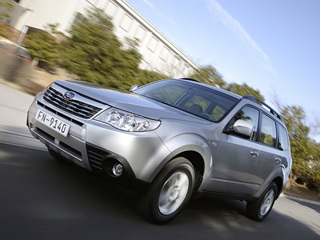
For all Subaru Forester modifications, in addition to the S -Edition, an ancient 4 -speed automatic is offered as an automatic transmission, the main enemy of the dynamics of the forester. A 5 -speeded automatic transmission from Subaru WRX STI is placed on a 263 -horsepower version, which, I must say, is also not enough stars from the sky.
In the behavior of the car, only one difference was significantly noticeable, the car began to react better to pressing the gas pedal. This is felt even when riding a Forester with an automatic transmission. For all modifications (except S -Edition), the same, long -outed 4 -speed gearbox is provided. It is unfortunate that Subaru does not have a more suitable and modern KP for its Foresters. Because the four steps by the standards of the present time are clearly not enough. This drawback is especially noticeable at high speeds: on the third roar, like a wounded bison, we are barely going on the fourth. But you can get used to it: you need to press the gas with a margin in time and not be afraid when the boxer angered by a decrease in the transmission of the transmission is displeased from under the hood. Fortunately, the roads in Belarus in the overwhelming majority are even and straight, like an arrow, so the shifts are very rare. And its 130-150 kilometers per hour on the Forester highway is easily and quite quietly: apparently, noise insulation was also improved.

On the Forester highway, it constantly requires slight steering. But on a primer, where zero is not so important, Subaru feels like a fish in water: the car goes smoothly in the skid, it is difficult to break through the suspension, and the smoothness does not deteriorate with an increase in speed. More than gas is less about Forester.
Complaints of customers about excessively soft and prone to build -up suspension were taken into account. Other rear shock absorbers are installed on 2011 cars, and the subframe received new bushings. Forester has become more stable, but did not overcome the tendency to a small, but noticeable change in the course on a high -speed line. Zero is almost not felt, so the driver is obliged to perform corrective actions by the steering wheel all the time.
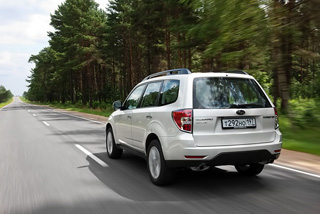
Oddly enough, for the Forester model, the Japanese use three options for a full -wheel drive system. A conical center differential operates on machines with mechanics, and the difference in rotation speeds is limited to viscousyft. On cars with a machine gun, a hydraulic multi -disc clowing is used, which, with the participation of the VDC stabilization system, varies the distribution of torque between the front and rear axles. The VTD -AWD system is installed in the S -EDITION, in which the intericental differential based on planetary transmission in the usual state transmits 55% of the moment to the rear axle and 45% to the front.
In general, going to Forester is quite comfortable on any road. He is not sensitive to the ruts, he is not afraid of holes and pardon, but on the country grader Forik and in his element. The tractor comb him for nothing, the potholes of the suspension swallows an amazing energy consumption without a hint of breakdown. At the same time, Forester, even on unstable coatings at high speed, is completely excellently controlled. And we control delicious. From the crossover you do not expect such lightness: the willingness to exhibit only for the discharge of gas, a smooth skid, a huge amount of time to adjust. And you can take a famously sideways, controlling the angle with one gas and a little helping the steering wheel. Willy-nilly, you will remember the successes of Subaru in a rally field. Great!
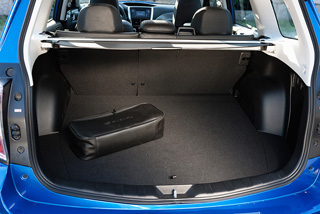
The volume of the trunk of the foreman, despite cubic forms, is not so large only 450 liters. The maximum width of the luggage compartment is 1587 millimeters, a depth of 960 millimeters, a height of 863 millimeters. And with folded rear seats, the volume grows to the impressive 1660 liters!
Now let's talk about the main innovation that came to us along with restyling about the 263 -horsepower version. There is no new power plant here yet. Horses were squeezed out of the already previous engine of the EJ series. Just because Subaru is not yet ready for a replacement for a turbo engine.
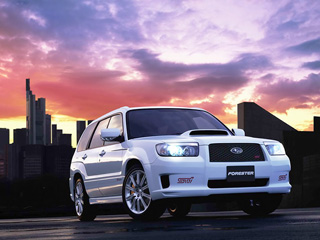
Here is the machine that may have pushed the Subarovites to create the S -Event Forester STI of the second (until 2006) generation (265 forces, a 6 -speed handle). Such Forik was intended for the domestic market of Japan and, accordingly, could only be bought right -handed.
Speaking at the beginning of the article about the Forester S -Edition as a STI heir, I honestly got a little excited. The STI version, produced for the local Japanese market in the second generation of Forester until 2006, was very hot. A real fan car! The Motor of the fastest Forester in history already developed 265 horsepower: two horses more than that of the modern S-EDION. In addition, the STI was equipped with only a 6 -speed mechanics, had a real sports suspension, a salon with special seats and a steering wheel, and an original body kit.
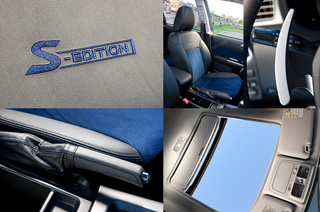
The S-EDITION version differs from the standard blue alcantar inserts, the branded logo on the backs of the seats, the steering wheel petals of the 5-speed machine and the special decoration of the parking brake lever. The panoramic sliding hatch in the roof in the database is offered only for the S-EDION version or for a 2.5-lit-free turbo modification in expensive Tu configuration.
The new machine has only an automatic transmission (a 5 -speed automatic from WRX STI), an interior with blue alcantar inserts, in the suspension shock absorbers with changed characteristics, instead of a body range, an original nameplate, and STI discs. Although they will warm the soul of the future owner. Because it's still not STI. This is fast, but not at all ultimatical, but rather a friendly crossover. And the absence of a handle even indirectly confirms this as an option.
I cherished the hope that the additional step of the machine and the steering wheel petals would significantly improve the situation with the gear shift. But this, alas, did not happen. Excess transmission, of course, helps to make the difference in the transfer numbers of the neighboring steps not so noticeable, but the five -stroke does not work very quickly. True, you can forget about the S -Edition of the box: everything solves power: 263 forces is perhaps a record for a crossover of this class (if you do not take into account premium models). S -EDITION is very fast for the barn, other suspension settings make it a little harder and more collected, and the steering wheel is much more transparent. Stinging on a straight line is no longer required, the nimble Forester is carried into the distance, like a bullet, under a characteristic sniping of a turbine.
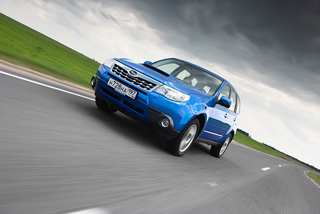
In the pendant Forester S-EDINITION OTHER shock absorbers. The car becomes a little more collected, although there are no cardinal differences from ordinary modifications. The most important thing: in the straight line S -edition is much more confident.
On the asphalt, S -Edition does not claim the title of sports car. A little better than an ordinary foric, but a high body rolls, despite the low arrangement of the opposition motor, and a strong insufficient rotability occurs at the entrance to the turn. Well, they tormented a little and enough. I am waiting for the next gravel site. And again delight! Again in the corners we go fan. Taking the S -Edition in the arc is so easy and simple that you recall the rally again. But even, if you do not build Ari Wattanen or Colin Makrey, but to reason from a completely civilian point of view, then we can say that the most powerful version of Forester on a bad road is not at all inferior to the smaller brothers. So not every car can calmly exceed a hundred in gravel. And Subaru can.
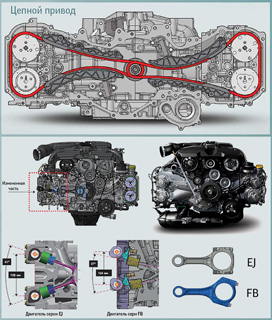
Atmospheric engines of the EJ series of 2.0 and 2.5 came to replace the new motors of the FB series. Despite the fact that the technical characteristics have changed slightly, Subaru engineers have done a huge amount of work aimed at optimizing the design of the unit, combustion of the mixture, improving the economy and reducing harmful emissions. The AVCS gas distribution phase mechanism is installed on new engines.
New engines have become longer. If earlier on the EJ20, the piston stroke was less than the diameter of the cylinder (75x92 millimeters), now, on the contrary, 90x84 millimeters. On a 2.5 -liter motor, instead of a ratio of 79x99.5, we have 90x94 millimeters. The growth of the piston’s course entailed an increase in the moment in the medium and low revolutions, but, in theory, it was also supposed to lead to an increase in engine dimensions. To prevent this from happening, the Japanese used a more reliable chain drive with gears of smaller diameter. The combustion chamber became more compact, as the angle of the collapse of the valves and the diameter of the piston decreased, the inlet channels were optimized, as a result of which the combustion of the mixture improved. The connecting rods have now become easier and gained a new shape, which made it available to remove the pistons after dismantling the head of the block. Also increased the productivity of the oil pump, a separate cooling system was used (for rapid heating, increasing the temperature of the oil in the sleeve and a decrease in friction), the inlet and release were converted. Nevertheless, the engines correspond only to Euro-4 standards, and for sale in Europe (Euro-5) they are equipped with a number of additional systems.
Unfortunately, our Belarusian voyage did not provide for sections with any serious off -road. Therefore, Forester’s cross -country ability and the difference between all types of transmissions failed to verify. But the overhangs are just as short, and a lot of competitors will envy the clearance of 215 millimeters (225 at the S-EDION).
For restyling, Forik was good in this, and hardly became worse, because no serious changes in the type of drive or in the suspension occurred. You remember that the Japanese just pressed the F5. Refresh, updating the contents of the page
Alternative
One of the most persistent and age -related fighters in the market of medium -sized Suzuki Grand Vitara crossovers. The main trump card is still the price. The simplest 1.6 -liter (106 horsepower) version with 5 -speed mechanics can be bought for only 829 thousand rubles. But there is not even music in such a car. The presence under the hood of a two -liter 140 -horsepower engine will entail a rise in price by 160 thousand rubles. The machine is another 40 thousand rubles. Vitara with a 2.4 -liter engine (169 forces), automatic transmission, leather salon, 6CD MP3 radio, 17 -inch discs and xenon costs 1.239 million rubles.
After the appearance of a 2.5 -liter (163 horsepower) front -wheel drive version, the initial price of the Mazda CX -7 fell to 1.130 million rubles. Such machines are equipped only with a 5 -speed automatic and sold only in the Touring configuration, which, however, is initially quite rich. Six programs of the privilege of 238-horsepower all-wheel drive turbo modification. In the Touring configuration, such a car can be bought for 1.285 million rubles. And in the Sport version (plus a leather interior, seats, rain sensor, 19-inch discs, Bose audio system) Mazda CX-7 costs 1.427 million rubles. Luke option only for sports.
Not so long ago, the updated Nissan X-Trail can be purchased for 995 thousand rubles. This is the price of a two -liter car (141 horses) on the handle. The same car with a variator costs 1.044 million rubles. The 2.5 -liter engine (169 forces) is aggregated only with a vast transmission (from 1 million 214 thousand 500 rubles). The advantageous difference between the X-Trail and most competitors have a turbodiesel version. 2.0d (150 forces) with a 6 -speed mechanical KP, which is sold for 1 million 174 thousand 500 rubles. A full -fledged 6 -speed machine is also installed on the diesel. Such X-Trail is the most expensive, 1 million 239 thousand 500 rubles.
Source: Motor magazine [August 2011]
Video Subaru Forester test drive since 2008
Subaru Forester Crash Video since 2008
Subaru Forester test drive since 2008
Subaru Forester Crash Test since 2008
Krassh Test: Detailed Information91%
Driver and passengers
73%
Pedestrians
91%
Children-passengers
86%
Active security system


